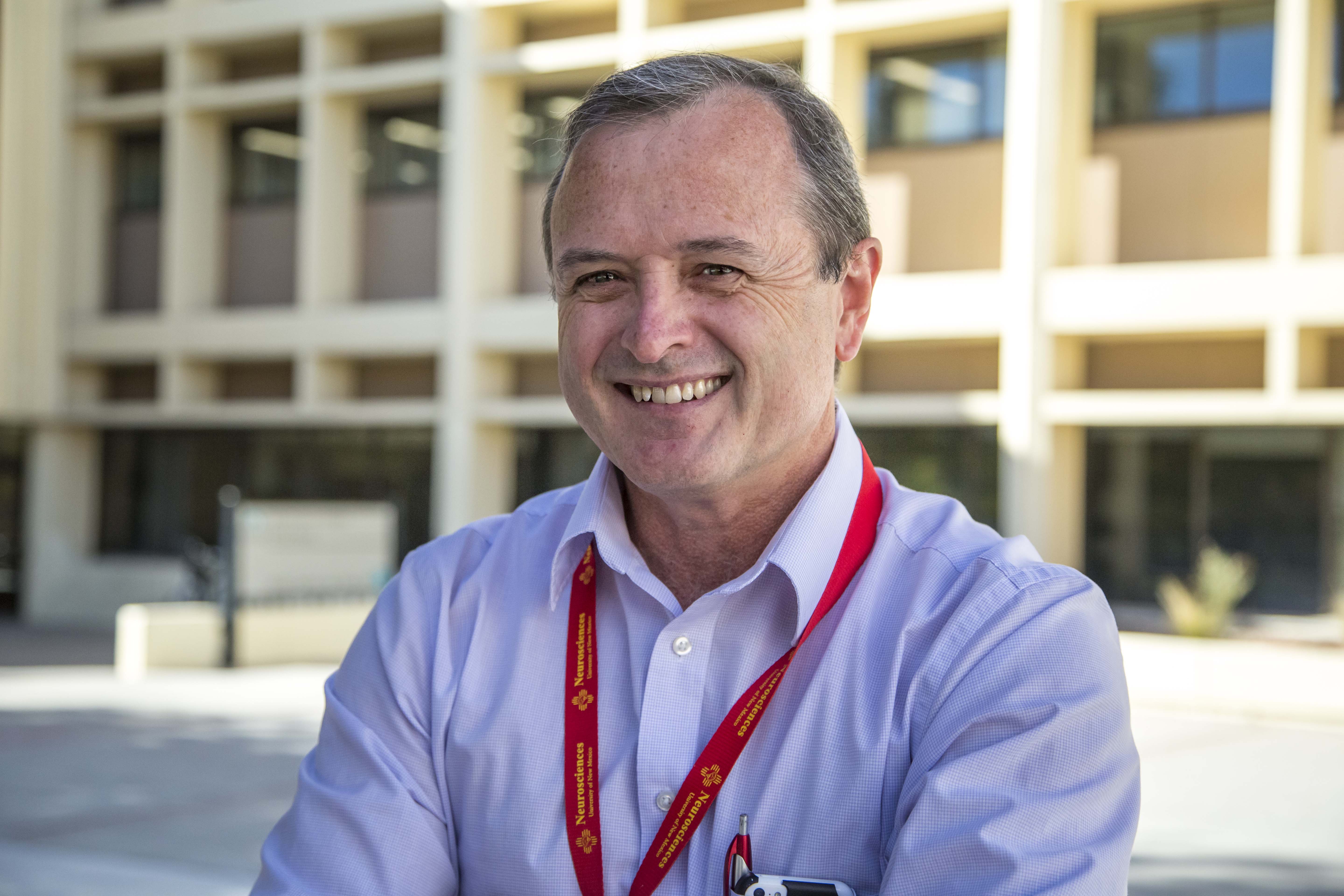Neurosurgeon Andrew Carlson and his colleagues at The University of New Mexico have partnered with two other institutions in a three-year $3.5 million U.S. Department of Defense research grant to explore targeted therapies for spreading brain depolarization.
Sometimes known as “brain tsunamis,” spreading depolarizations are waves of neuronal injury that ripple outward from the site of a trauma, aneurysm or stroke, temporarily shutting down the brain’s electrical activity. Neuroscientists are coming to realize that they are a major contributor to traumatic brain injury.
Over the past 10 years, Carlson and Bill Shuttleworth, PhD, chair of the UNM Department of Neurosciences, have been at the forefront of research into understanding the underlying causes of brain tsunamis and identifying potential treatments.
In the Improving Neurotrauma by Depolarization Inhibition with Combination Therapy (INDICT) study, Carlson and collaborators at the University of Cincinnati and University of Pennsylvania will focus on providing precision care with targeted treatment of brain tsunamis.
The research is building on Carlson’s first-in-the-world pilot study suggesting that ketamine, a widely used sedative, could block brain tsunamis. “It’s an exciting continuation of the work that we’ve done here that has built us up to national standing with the world leaders who have done this kind of research,” Carlson said.
During the INDICT study, patients in UNM Hospital’s Neurosciences Intensive Care Unit will be closely monitored using multimodal data collection as physicians tailor treatments specific to their neurological status. Using specialized software, “We can record the exact timing of when certain interventions happen,” Carlson says. That information will enable the researchers to determine which treatments work best to stop the spreading depolarizations.
Shuttleworth says scientists first suspected that ketamine, a drug known for its dissociative and anesthetic effects, might be an effective treatment when physicians noticed that spreading depolarization was halted after brain injury patients being sedated with an anesthetic called propofol were switched to ketamine.
In his lab Shuttleworth and his team studied N-methyl-D-aspartate (NMDA) receptors on the surface of neurons, which bind with an excitatory neurotransmitter called glutamate. When the brain suffers a trauma or is starved of oxygen during a stroke, neurons dump their glutamate, which spreads to neighboring neurons and shuts down their electrochemical signaling in a slowly radiating wave that starts to kill brain cells.
“These neurons are struggling to stay alive, but they just get overwhelmed and can’t recover,” Shuttleworth says. His lab has found that ketamine works by binding to NMDA receptors and protecting neurons from the glutamate wave. “Ketamine throws them a lifeline and makes the insult less serious,” he says.
Shuttleworth’s findings “really helped inform us in the study we published a few years ago where we had very sick patients with brain injury and aneurysm bleeds,” Carlson says. During the pilot study, patients in the UNMH Neuro ICU received alternate doses of ketamine and other sedatives. “In the times that they were on ketamine they had fewer brain tsunamis than when they were on other sedatives,” Carlson says.
“This is a great example of translational research – research that is developed in preclinical models and in benchtop models,” he adds. “Things that happen clinically get tested in preclinical models.”
The finding could potentially have an impact in other types of brain injury, such as concussion, Carlson says.

If we’ve found that fundamental mechanism of how these brain injuries occur we could make progress across a lot of different neurologic injuries.
“It’s really exciting, because as we understand more about the mechanism about how spreading depolarization works, we understand that it probably is the fundamental mechanism of how brain injury and stroke appears,” he says. “If we’ve found that fundamental mechanism of how these brain injuries occur, we could make progress across a lot of different neurologic injuries.”
The INDICT trial was designed as a collaboration between Carlson, Jed Hartings at the University of Cincinnati and Ramani Balu at the University of Pennsylvania. Each investigator brings a unique perspective to the study design, Carlson as a neurosurgeon, Hartings as a PhD neurophysiologist and Balu as an MD/PhD neuro-intensivist.
In addition to a longstanding collaboration with Shuttleworth, Carlson credits UNM colleagues with contributing to brain tsunami research, including Michel Torbey, MD, chair of the Department of Neurology, Russell Morton, PhD, assistant professor in the Department of Neuroscience, Christopher Abbott, MD, associate professor in the Department of Psychiatry & Behavioral Sciences, Bert Davis, PhD, in the Department of Internal Medicine, and George Luger, PhD, professor in the Department of Computer Science.
With the ongoing study, coupled with the recent groundbreaking for UNM’s Interdisciplinary Substance Use and Brain Injury Core Facility (ISUBI), Carlson believes UNM has put in place the building blocks for a comprehensive brain tsunami research program.
“We have all the pieces to be the international destination, and have gotten to this point with committed investigators who have used institutional support mechanisms in building interest,” he says.

